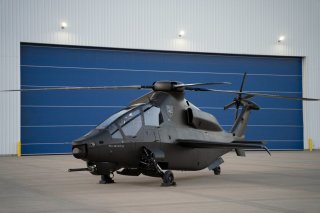Computer Simulations Are Defining the Army's Search for a New Helicopter
Bell’s Invictus 360, a scout helicopter now being offered to the U.S. Army in the Future Attack and Reconnaissance Aircraft (FARA) program, has also been making rapid progress with digital computer simulations.
The U.S. Air Force’s now airborne, yet highly secret sixth-generation stealth fighter jet; the new Ground-Based Strategic Deterrent intercontinental ballistic missile (ICBM); and the U.S. Army’s emerging Optionally Manned Fighting Vehicle have all been massively successful examples of accelerated, high-tech programs which are blasting onto the scene earlier than anticipated.
This is due to the fact that computer simulations are now able to replicate weapons’ performance parameters and key technical specifics with great fidelity and precision, a technical breakthrough enabling weapons developers the opportunity to assess multiple designs without having to spend years “bending metal” to build construction prototypes. Design details and weapons specifics can all be evaluated in great detail through “digital engineering,” a high-tech method of weapons assessments using computer simulation to optimize development.
Bell’s Invictus 360, a scout helicopter now being offered to the U.S. Army in the Future Attack and Reconnaissance Aircraft (FARA) program, has also been making rapid progress with digital computer simulations. The new, sleek, stealthy-looking helicopter is now 90 percent complete awaiting its new General Electric-built Improved Turbine Engine Program (ITEP) engine, yet many of its subsystems, weapons, sensors, and communications systems are still being refined and improved upon through computer simulation. Bell has established a specific Systems Integration Lab (SIL), described in part as a deconstructed version of the aircraft, which includes advanced computer modeling and a cockpit simulator.
“Essentially, we are flying the aircraft today in this simulation lab and on all the same components that are on the aircraft. We’re using the power generators and everything else, and really flying the aircraft now. It is such a high fidelity that we will fly every mission that we fly in a prototype in the SIL. Before we go fly, the pilots will do all of the test testing of the aircraft in the SIL first, and then they’ll fly,” Chris Gehler, vice president and program director of FARA at Bell, told The National Interest in an interview.
Part of the work in the SIL is naturally devoted to what Bell weapons developers call “pilot assist,” meaning safety features built in to protect pilots and advanced computing engineered to perform key data organization and analysis functions in the cockpit.
“What we’d like to do is have as much pilot assist as available in the aircraft, in the weapon systems, and in the mission equipment to help the pilot in the aircraft but also help him stay safe while he is actually managing the battlefield,” Gehler explained.
Some of the safety testing, for instance, is designed to identify and refine “emergency” procedures based on how the aircraft may degrade over time or be impacted by enemy weapons.
“It has segmented partitions for safety reasons for flight aspects and for mission equipment, but running over the same kind of tunnel that has open standards parameters. The Army gives everybody the design space such that they can bring on weapons systems, a new update to aircraft survivability. It’s an integrated modular avionics approach rather than a federated standalone system,” Gehler explained.
Bell engineers explain that part of the progress with the Invictus pertains to specific synergies with technologies also developed for the V-280 Valor tiltrotor aircraft now being offered for the Army’s Future Long Range Assault Aircraft program.
“Between our 360 and our 280, we have a common digital backbone and very common flight control computers. Essentially, it is an approach that’s really about integrated modular avionics, that has separate system safety aspects for flight controls, and mission equipment,” Gehler said.
Kris Osborn is the Defense Editor for the National Interest. Osborn previously served at the Pentagon as a Highly Qualified Expert with the Office of the Assistant Secretary of the Army—Acquisition, Logistics & Technology. Osborn has also worked as an anchor and on-air military specialist at national TV networks. He has appeared as a guest military expert on Fox News, MSNBC, The Military Channel, and The History Channel. He also has a Master’s Degree in Comparative Literature from Columbia University.
Image courtesy of Bell.

